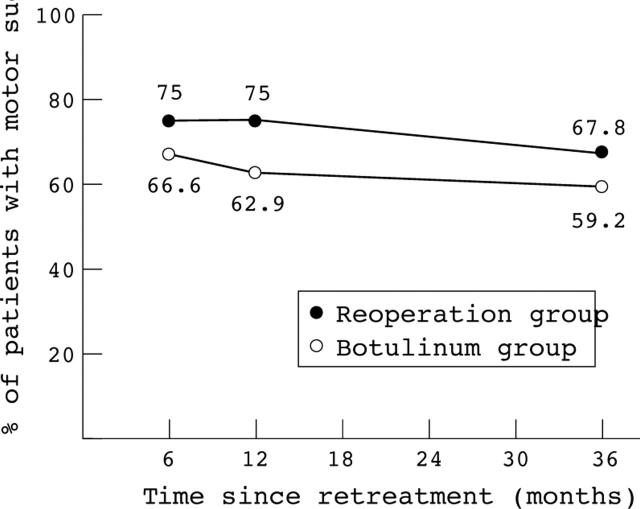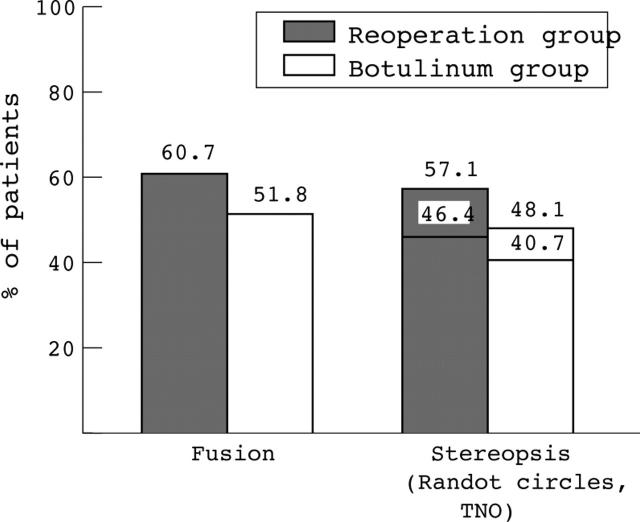Abstract
AIM—To compare the efficacy of reoperation and botulinum toxin injection in treating infantile esotropes early after unsatisfactory surgical alignment. METHODS—55 strabismic children who had been unsuccessfully operated for infantile esotropia were randomised to reoperation (28 patients) or botulinum toxin injection (27 patients). The motor outcomes (percentage of successful motor outcome and percentage change in deviation) were compared at 6 months, 1 year, and 3 years after retreatment, and the sensory outcomes (percentage with fusion ability and stereo perception) at the 3 year follow up visit. RESULTS—The motor and sensory outcomes and the stability of motor results were similar in patients reoperated and treated with botulinum injection. At the 3 year visit 67.8% and 59.2% of children were, respectively, within 8 prism dioptres of orthotropia (p=0.72). The frequency of fusion ability was, respectively, 60.7% and 51.8% (p=0.71), and the frequency of stereo perception (⩽400 seconds of arc, Randot circles), 57.1% and 48.1% (p=0.70). The botulinum injection was more likely to be effective when carried out in the 6 months following initial surgery. CONCLUSIONS—Botulinum injection is a rapid and less invasive alternative to reoperation in children who have been unsuccessfully treated with surgery to correct infantile esotropia.
Full Text
The Full Text of this article is available as a PDF (120.4 KB).
Figure 1 .
Percentages of patients with motor success in the two treatment groups at different moments of the follow up after retreatment (months). Motor success is defined as deviation of 0-8 prism dioptres by the simultaneous prism and cover at 6 metres. The percentages observed are similar in the two groups at 6 months (p=0.72), 1 year (p=0.50), and 3 years (p=0.72). The stability of the motor success rates over the follow up is noticeable.
Figure 2 .
Percentages of patients with fusion and stereo perception in the two treatment groups. Fusion was acceptable when detected by both the Worth 4 dot at near and the Bagolini lenses. The upper values in the stereopsis bars correspond to the percentages obtained with the Randot circles (at least 400 seconds of arc) and the lower values to those with the TNO test (at least 480 seconds of arc). The difference is not significant in the fusion (p=0.71) and in the stereo perception percentages as measured by the Randot circles (p=0.70) and TNO (p=0.90).
Selected References
These references are in PubMed. This may not be the complete list of references from this article.
- Bartley G. B., Dyer J. A., Ilstrup D. M. Characteristics of recession-resection and bimedial recession for childhood esotropia. Arch Ophthalmol. 1985 Feb;103(2):190–195. doi: 10.1001/archopht.1985.01050020042015. [DOI] [PubMed] [Google Scholar]
- Biglan A. W., Burnstine R. A., Rogers G. L., Saunders R. A. Management of strabismus with botulinum A toxin. Ophthalmology. 1989 Jul;96(7):935–943. doi: 10.1016/s0161-6420(89)32776-x. [DOI] [PubMed] [Google Scholar]
- Birch E. E., Stager D. R., Berry P., Everett M. E. Prospective assessment of acuity and stereopsis in amblyopic infantile esotropes following early surgery. Invest Ophthalmol Vis Sci. 1990 Apr;31(4):758–765. [PubMed] [Google Scholar]
- Burns C. L., Gammon J. A., Gemmill M. C. Ptosis associated with botulinum toxin treatment of strabismus and blepharospasm. Ophthalmology. 1986 Dec;93(12):1621–1627. doi: 10.1016/s0161-6420(86)33520-6. [DOI] [PubMed] [Google Scholar]
- Helveston E. M., Ellis F. D., Schott J., Mitchelson J., Weber J. C., Taube S., Miller K. Surgical treatment of congenital esotropia. Am J Ophthalmol. 1983 Aug;96(2):218–228. doi: 10.1016/s0002-9394(14)77790-6. [DOI] [PubMed] [Google Scholar]
- Helveston E. M. Reoperations in strabismus. Ophthalmology. 1979 Aug;86(8):1379–1388. doi: 10.1016/s0161-6420(79)37007-5. [DOI] [PubMed] [Google Scholar]
- Ing M. R. Early surgical alignment for congenital esotropia. Ophthalmology. 1983 Feb;90(2):132–135. doi: 10.1016/s0161-6420(83)34586-3. [DOI] [PubMed] [Google Scholar]
- Ing M., Costenbader F. D., Parks M. M., Albert D. G. Early surgery for congenital esotropia. Am J Ophthalmol. 1966 Jun;61(6):1419–1427. doi: 10.1016/0002-9394(66)90480-6. [DOI] [PubMed] [Google Scholar]
- King R. A., Calhoun J. H., Nelson L. B. Reoperations for esotropia. J Pediatr Ophthalmol Strabismus. 1987 May-Jun;24(3):136–140. doi: 10.3928/0191-3913-19870501-09. [DOI] [PubMed] [Google Scholar]
- Kittleman W. T., Mazow M. L. Reoperations in esotropia surgery. Ann Ophthalmol. 1986 May;18(5):174–177. [PubMed] [Google Scholar]
- Kushner B. J., Morton G. V. A randomized comparison of surgical procedures for infantile esotropia. Am J Ophthalmol. 1984 Jul 15;98(1):50–61. doi: 10.1016/0002-9394(84)90188-0. [DOI] [PubMed] [Google Scholar]
- Lingua R. W. Sequelae of botulinum toxin injection. Am J Ophthalmol. 1985 Aug 15;100(2):305–307. doi: 10.1016/0002-9394(85)90797-4. [DOI] [PubMed] [Google Scholar]
- Magoon E. H. Chemodenervation of strabismic children. A 2- to 5-year follow-up study compared with shorter follow-up. Ophthalmology. 1989 Jul;96(7):931–934. [PubMed] [Google Scholar]
- Magoon E., Scott A. B. Botulinum toxin chemodenervation in infants and children: an alternative to incisional strabismus surgery. J Pediatr. 1987 May;110(5):719–722. doi: 10.1016/s0022-3476(87)80009-4. [DOI] [PubMed] [Google Scholar]
- McNeer K. W., Tucker M. G., Spencer R. F. Botulinum toxin management of essential infantile esotropia in children. Arch Ophthalmol. 1997 Nov;115(11):1411–1418. doi: 10.1001/archopht.1997.01100160581010. [DOI] [PubMed] [Google Scholar]
- Repka M. X., Connett J. E., Scott W. E. The one-year surgical outcome after prism adaptation for the management of acquired esotropia. Ophthalmology. 1996 Jun;103(6):922–928. doi: 10.1016/s0161-6420(96)30586-1. [DOI] [PubMed] [Google Scholar]
- Scott A. B., Magoon E. H., McNeer K. W., Stager D. R. Botulinum treatment of childhood strabismus. Ophthalmology. 1990 Nov;97(11):1434–1438. doi: 10.1016/s0161-6420(90)32390-4. [DOI] [PubMed] [Google Scholar]
- Scott W. E., Reese P. D., Hirsh C. R., Flabetich C. A. Surgery for large-angle congenital esotropia. Two vs three and four horizontal muscles. Arch Ophthalmol. 1986 Mar;104(3):374–377. doi: 10.1001/archopht.1986.01050150074030. [DOI] [PubMed] [Google Scholar]
- Spencer R. F., McNeer K. W. Botulinum toxin paralysis of adult monkey extraocular muscle. Structural alterations in orbital, singly innervated muscle fibers. Arch Ophthalmol. 1987 Dec;105(12):1703–1711. doi: 10.1001/archopht.1987.01060120101035. [DOI] [PubMed] [Google Scholar]
- Tejedor J., Rodríguez J. M. Retreatment of children after surgery for acquired esotropia: reoperation versus botulinum injection. Br J Ophthalmol. 1998 Feb;82(2):110–114. doi: 10.1136/bjo.82.2.110. [DOI] [PMC free article] [PubMed] [Google Scholar]
- Wright K. W., Edelman P. M., McVey J. H., Terry A. P., Lin M. High-grade stereo acuity after early surgery for congenital esotropia. Arch Ophthalmol. 1994 Jul;112(7):913–919. doi: 10.1001/archopht.1994.01090190061022. [DOI] [PubMed] [Google Scholar]
- von Noorden G. K. A reassessment of infantile esotropia. XLIV Edward Jackson memorial lecture. Am J Ophthalmol. 1988 Jan 15;105(1):1–10. doi: 10.1016/0002-9394(88)90113-4. [DOI] [PubMed] [Google Scholar]




